Terran Orbital expects $180 million payment from Rivada Space this year
Wednesday, 16 August 2023 22:08

Chandrayaan-3 nears landing with successful orbital adjustments
Wednesday, 16 August 2023 20:10 The Chandrayaan-3 spacecraft has successfully adjusted its orbit to 153 km x 163 km, as reported by the Indian Space Research Organisation (ISRO) today. This precise maneuvering is a pivotal step as the mission gears up for its anticipated soft landing on the Moon's South Polar region on August 23.
In the days leading up to this current status, the spacecraft had undergone significant orbi
The Chandrayaan-3 spacecraft has successfully adjusted its orbit to 153 km x 163 km, as reported by the Indian Space Research Organisation (ISRO) today. This precise maneuvering is a pivotal step as the mission gears up for its anticipated soft landing on the Moon's South Polar region on August 23.
In the days leading up to this current status, the spacecraft had undergone significant orbi NASA adds water detection instrument to Lunar Trailblazer spacecraft
Wednesday, 16 August 2023 20:10 As NASA's Lunar Trailblazer spacecraft nears completion, scientists have added a piece of equipment designed to detect water.
"Built by the University of Oxford in England and contributed by the UK Space Agency, the Lunar Thermal Mapper (LTM) joins the High-resolution Volatiles and Minerals Moon Mapper (HVM3), which was integrated with the spacecraft late last year," NASA said in a pres
As NASA's Lunar Trailblazer spacecraft nears completion, scientists have added a piece of equipment designed to detect water.
"Built by the University of Oxford in England and contributed by the UK Space Agency, the Lunar Thermal Mapper (LTM) joins the High-resolution Volatiles and Minerals Moon Mapper (HVM3), which was integrated with the spacecraft late last year," NASA said in a pres Q&A: Sustainability in space travel can aid efforts here on Earth
Wednesday, 16 August 2023 19:57
Dr. Angelo Vermeulen is a space systems researcher at Delft University of Technology in the Netherlands, where he explores advanced concepts for interstellar exploration. Over the past decade, he has collaborated closely with the European Space Agency's (ESA) MELiSSA program, developing concepts for bioregenerative life support systems for space. In such systems, a variety of microorganisms progressively break down human waste and the resulting compounds are harnessed by plants to produce oxygen and food for the crew.
Beyond his scientific pursuits, Dr Vermeulen is also an accomplished artist and a co-founder of the SEADS (Space Ecologies Art and Design) collective. SEADS creates artworks that seamlessly integrate concepts and technologies from a diverse array of scientific disciplines, including biology, neuroscience, computer science, and astrophysics.
He is the author of a recently published Frontiers in Astronomy and Space Sciences article in which he and his co-authors describe a new model that theoretically produces all required food and oxygen during long-duration and remote space missions, removing the necessity for resupply from Earth.
Hydra shaker table simulates the vibration forces of a rocket launch for satellite testing
Wednesday, 16 August 2023 19:48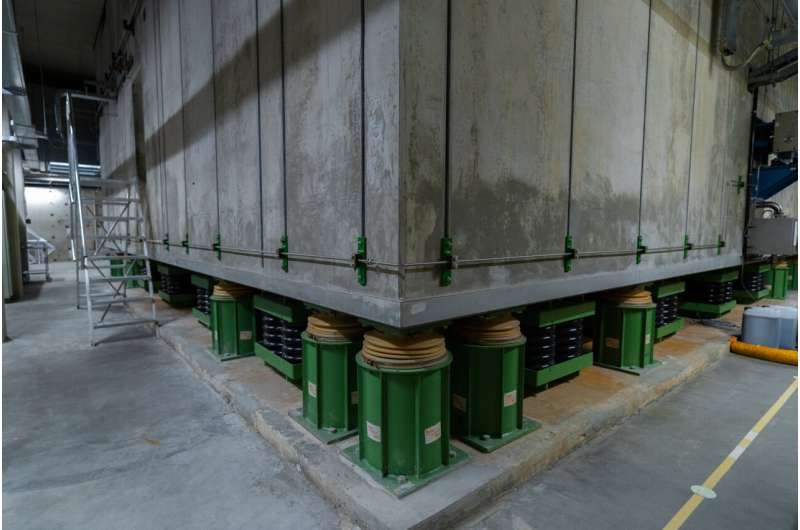
As the earthquake-strength Hydra shaker table simulates the vibration forces of a rocket launch for satellite testing, it is only this concrete block and the dampeners and springs supporting it that prevent the rest of the European Space Agency's ESTEC Test Center from also suffering the shakes.
The most powerful and precisely controllable of the shaker tables the ESA uses for satellite testing at its Test Center in Noordwijk, the Netherlands, is the multi-axis Hydra, which is capable of vibrating test items weighing many tons.
Seen from the cleanroom above, the hydraulically-powered Hydra appears to be simply a 5.5 x 5.5 m aluminum platform lying flush with the floor. But this plate is only the top of an 18 metric ton test table which is moveable using eight hydraulic actuators, in the same manner as a flight simulator machine.
This test table is enclosed within a 1,400 metric ton concrete 'seismic foundation' block. This block rests in turn on the set of springs and dampers, which isolate it, preventing potentially damaging vibrations from spreading through the rest of the building.
A robot with expandable appendages could explore Martian caves and cliffs
Wednesday, 16 August 2023 19:33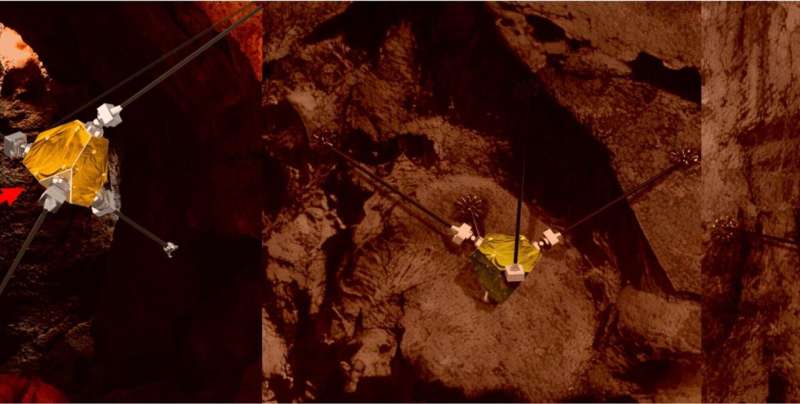
Plenty of areas in the solar system are interesting for scientific purposes but hard to access by traditional rovers. Some of the most prominent are the caves and cliffs of Mars—where exposed strata could hold clues to whether life ever existed on the Red Planet. So far, none of the missions sent there has been able to explore those difficult-to-reach places. But a mission concept from a team at Stanford hopes to change that.
The concept, known as ReachBot, is a robot that can support itself using multiple articulated appendages to navigate terrain that would be difficult to reach using other navigational techniques. In addition to being able to traverse complex ground patterns, it could also, in theory, at least scale sheer cliff faces.
It was initially pitched as a NASA Institute for Advanced Concepts project, where it was awarded a Phase I grant back in 2021. The authors describe the idea as a fusion of two separate technologies developed for different purposes: mobile manipulation robots and deployable space structures.
Mobile manipulation robots are relatively common in space exploration.
Momentus cuts workforce while evaluating strategic options
Wednesday, 16 August 2023 18:06

NASA's lunar trailblazer gets final payload for moon water hunt
Wednesday, 16 August 2023 16:12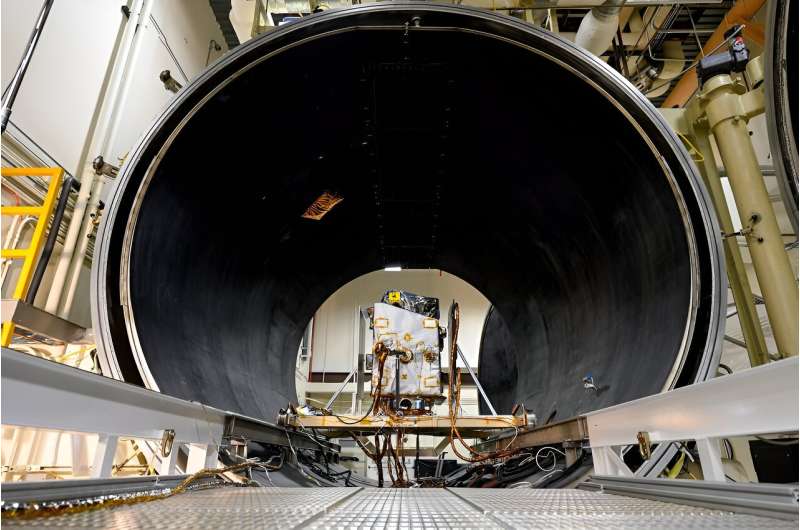
NASA's Lunar Trailblazer is nearing completion now that its second and final cutting-edge science instrument has been added to the small spacecraft. Built by the University of Oxford in England and contributed by the UK Space Agency, the Lunar Thermal Mapper (LTM) joins the High-resolution Volatiles and Minerals Moon Mapper (HVM3), which was integrated with the spacecraft late last year. Together, the instruments will enable scientists to determine the abundance, location, and form of the moon's water.
Led by Caltech in Pasadena, California, Lunar Trailblazer has a mass of about 440 pounds (200 kilograms) and measures only 11.5 feet (3.5 meters) wide with its solar panels fully deployed.
SkyWatch to offer integrated radar-optical satellite imagery
Wednesday, 16 August 2023 15:44
Space Force extends Wallaroo’s contract for on-orbit AI applications
Wednesday, 16 August 2023 15:06

XRISM spacecraft will open new window on the X-ray cosmos
Wednesday, 16 August 2023 13:00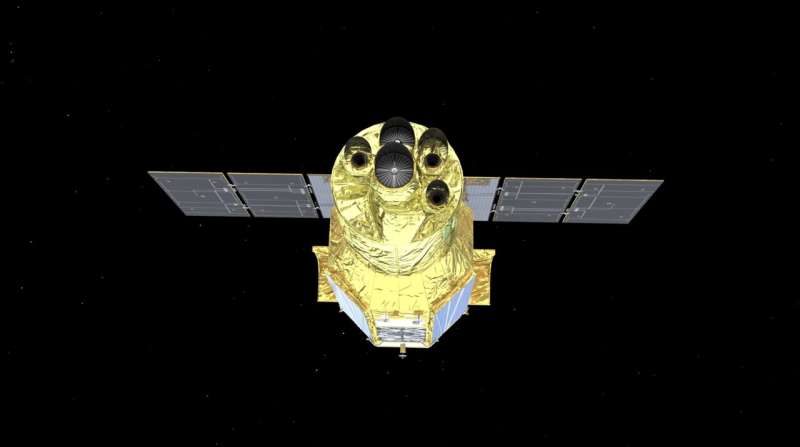
The upcoming XRISM (X-ray Imaging and Spectroscopy Mission, pronounced "crism") spacecraft will study the universe's hottest regions, largest structures, and objects with the strongest gravity.
Led by JAXA (Japan Aerospace Exploration Agency), XRISM will peer into these cosmic extremes using spectroscopy, the study of how light and matter interact. In this explainer, video producer Sophia Roberts from NASA's Goddard Space Flight Center walks us through how understanding spectroscopy deepens our knowledge of the universe.
"I think we all get excited for the beautiful images we get from missions like NASA's James Webb Space Telescope," Roberts said. "But after taking a deep dive into spectroscopy, I really appreciate the critical context it gives scientists about the story behind those pictures.
New data reveal US space economy's output is shrinking—an economist explains in 3 charts
Wednesday, 16 August 2023 12:39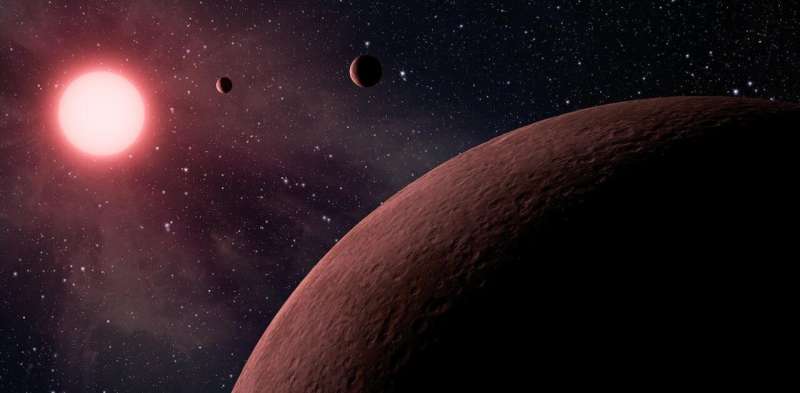
The space industry has changed dramatically since the Apollo program put men on the moon in the late 1960s.
Today, over 50 years later, private companies are sending tourists to the edge of space and building lunar landers. NASA is bringing together 27 countries to peacefully explore the moon and beyond, and it is using the James Webb Space Telescope to peer back in time. Private companies are playing a much larger role in space than they ever have before, though NASA and other government interests continue to drive scientific advances.
I'm a macroeconomistwho's interested in understanding how these space-related innovations and the growing role of private industry have affected the economy.
Russia's Luna-25 probe to reach Moon orbit
Wednesday, 16 August 2023 09:27 Moscow's Luna-25 lander is due to reach the Moon's orbit Wednesday, in the first such Russian mission in almost 50 years, according to the schedule of space agency Roscosmos.
With the lunar launch, Moscow's first since 1976, Russia is seeking to restart and rebuild on the Soviet Union's pioneering space programme.
The lander is set to revolve 100 kilometres (62 miles) above the Moon's su
Moscow's Luna-25 lander is due to reach the Moon's orbit Wednesday, in the first such Russian mission in almost 50 years, according to the schedule of space agency Roscosmos.
With the lunar launch, Moscow's first since 1976, Russia is seeking to restart and rebuild on the Soviet Union's pioneering space programme.
The lander is set to revolve 100 kilometres (62 miles) above the Moon's su NASA's $985 million Psyche mission to all-metal asteroid nears liftoff
Wednesday, 16 August 2023 09:27 Preparations are proceeding for the early October launch of a NASA orbiter that uses futuristic electric propulsion technology for a rendezvous with 16 Psyche, the heart of a demolished planet believed to be made almost entirely of iron.
Named after its interplanetary target, the $985 million mission is intended to help scientists determine whether the 140-mile-wide asteroid - which varie
Preparations are proceeding for the early October launch of a NASA orbiter that uses futuristic electric propulsion technology for a rendezvous with 16 Psyche, the heart of a demolished planet believed to be made almost entirely of iron.
Named after its interplanetary target, the $985 million mission is intended to help scientists determine whether the 140-mile-wide asteroid - which varie Enjoying the Climb: Sols 3916-3918
Wednesday, 16 August 2023 09:27 Earth planning date: Friday, August 11, 2023: In this weekend's plan, Curiosity is behaving much as you would as you climb a mountain. You pause occasionally to look around at what lies beneath your boots - the reward for your hard work up to that point. You also take time to enjoy the view and turn your gaze uphill to the path ahead - the unknown enticing you forward.
To do the former, Cu
Earth planning date: Friday, August 11, 2023: In this weekend's plan, Curiosity is behaving much as you would as you climb a mountain. You pause occasionally to look around at what lies beneath your boots - the reward for your hard work up to that point. You also take time to enjoy the view and turn your gaze uphill to the path ahead - the unknown enticing you forward.
To do the former, Cu 